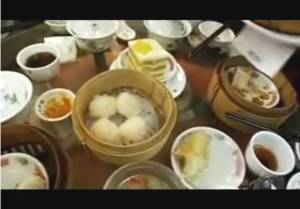Anthony Bourdain travels to the Mecca of Asian cooking—Hong Kong. Hong Kong is a wonderland of colors, lights and speed, a perfect marriage of East and West, modern and traditional. Relating fast-paced and hectic Hong Kong to a giant gastronomic pinball machine, Anthony arrives in Hong Kong ready to pull the lever and let himself go as he plunges head first into all things edible.
Introduction:
Hong Kong is one of two special administrative regions (SARs) of the People's Republic of China (PRC), the other being Macau. Under the principle of "one country, two systems", Hong Kong has a different political system from mainland China.
The East India Company made the first sea venture to China in 1699, and the region's trade with British merchants developed rapidly soon after. By 1773, the British reached a landmark 1,000 chests of opium in Canton with China consuming 2,000 chests annually by 1799. In 1839, the refusal by Qing Dynasty authorities to import opium resulted in the First Opium War (1839–42) between China and Britain. Hong Kong subsequently became a colony of the British Empire.
Originally confined to Hong Kong Island, the colony's boundaries were extended in stages to the Kowloon Peninsula and the New Territories, after China's defeat in the Second Opium War, in 1860. Hong Kong was occupied by Japan during the Pacific War, after which the British resumed control until 1997, when the PRC regained sovereignty, officially ending 156 years of British colonial rule.
Economy:
Tourism in Hong Kong, along with international trade and financial services, are the three main sources of income for Hong Kong. Hong Kong is one of the world's leading international financial centres. It has a major capitalist service economy characterised by low taxation and free trade, and the currency, Hong Kong dollar, is the ninth most traded currency in the world.
With one of the greatest concentrations of corporate headquarters in the Asia-Pacific region, Hong Kong is known as one of the Four Asian Tigers for its high growth rates and rapid development from the 1960s to the 1990s. The Hong Kong Stock Exchange is the seventh largest in the world.
Hong Kong has numerous high international rankings in various aspects. For instance, its economic freedom, financial and economic competitiveness, quality of life, corruption perception, Human Development Index, etc., are all ranked highly. However, Hong Kong faces uncertainty over its future due to the growing mainland China economy, and its relationship with the PRC government in areas such as democratic reform and universal suffrage.
Demographics:
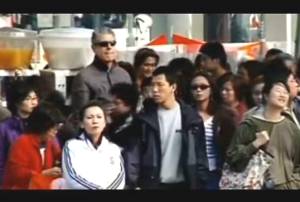 With a population of seven million people, Hong Kong is one of the most densely populated areas in the world. About 95% of the people of Hong Kong are of Chinese descent. Hong Kong's Han majority originate mainly from the Guangzhou and Taishan regions in Guangdong province. The remaining 5% of the population is composed of non-ethnic Chinese. There is a South Asian population of Indians, Pakistanis and Nepalese; some Vietnamese refugees have become permanent residents of Hong Kong. There are also Europeans (mostly British), Americans, Canadians, Japanese, and Koreans working in the city's commercial and financial sector. In 2008, there were an estimate of 252,500 foreign domestic helpers from Indonesia and the Philippines working in Hong Kong.
With a population of seven million people, Hong Kong is one of the most densely populated areas in the world. About 95% of the people of Hong Kong are of Chinese descent. Hong Kong's Han majority originate mainly from the Guangzhou and Taishan regions in Guangdong province. The remaining 5% of the population is composed of non-ethnic Chinese. There is a South Asian population of Indians, Pakistanis and Nepalese; some Vietnamese refugees have become permanent residents of Hong Kong. There are also Europeans (mostly British), Americans, Canadians, Japanese, and Koreans working in the city's commercial and financial sector. In 2008, there were an estimate of 252,500 foreign domestic helpers from Indonesia and the Philippines working in Hong Kong.
Hong Kong's de facto official language is Cantonese Chinese. English is also an official language, and is spoken by 3.1% of the population as an everyday language and by 34.9% of the population as a second language.
Culture & Recreation:
Situated on China's south coast and enclosed by the Pearl River Delta and South China Sea, Hong Kong is renowned for its expansive skyline and deep natural harbor. Hong Kong is frequently described as a place where "East meets West", reflecting the culture's mix of the territory's Chinese roots with influences from its time as a British colony. Hong Kong balances a modernized way of life with traditional Chinese practices. Concepts like feng shui are taken very seriously.
Food holds an important place in Hong Kong culture. The fusion of east and west also characterises Hong Kong's cuisine, where dim sum, hot pot, and fast food restaurants coexist with haute cuisine. Hong Kong carries the reputable label of "Gourmet Paradise" and "World's Fair of Food".
Hong Kong is identified by its materialistic culture and high levels of consumerism. Shops from the lowest end to the most upscale pack the streets in close proximity. Some popular shopping destinations include Mongkok, Tsim Sha Tsui, and Causeway Bay.
Hong Kong calls itself an "entertainment hub". Its martial arts film genre gained a high level of popularity in the late 1960s and 1970s. Several Hollywood performers, notable actors and martial artists have originated from Hong Kong cinema, notably Bruce Lee, Jackie Chan, Chow Yun-fat, Michelle Yeoh, Maggie Cheung and Jet Li. A number of Hong Kong film-makers have achieved widespread fame in Hollywood, such as John Woo, Wong Kar-wai, and Stephen Chow.
Cantopop has dominated and become synonymous with local music culture since its birth in Hong Kong. While many other forms of music exist, Cantopop still enjoys mass popularity. However, the global influence of Mandarin has influenced the style. Mandopop from Taiwan and China is fast gaining ground. Most artists are essentially multilingual, singing in both Cantonese and Mandarin. Hong Kong English pop and western music are also popular among Hong Kongers.
When not at work, Hongkongers devote much time to leisure. Mahjong is a popular social activity, and family and friends may play for hours at festivals and on public holidays in homes and mahjong parlours. The image of elderly men playing Chinese chess in public parks, surrounded by watching crowds, is common. Other board games such as Chinese checkers are also enjoyed by people of all ages. Among teenagers, shopping, eating out, karaoke and video games are common.
Episode Recap:
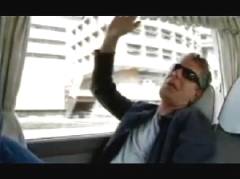 Anthony Bourdain starts his journey with an excuriating tour bus ride, which is exactly the sort of cliché tourist activity he hates.
Anthony Bourdain starts his journey with an excuriating tour bus ride, which is exactly the sort of cliché tourist activity he hates.
Temple Street: After escaping from the bus, Anthony heads over to Temple Street on the Kowloon peninsula. Temple Street is well known for its night market and the busiest flea market at night in the territory. Popular with both tourists and locals alike in the evening, it is common to see the place crowded at dusk. It sells cheap merchandise and food items.
Four Seasons Clay Pot Restaurant: Anthony meets up with Josh, a friend and native food blogger at the Four Seasons Clay Pot Restaurant. Anthony tries the traditional Hong Kong clay pot rice with Chinese sausage and smoked duck; Josh has the chicken and salt fish
Long Kee Noodle Shop: Anthony and Josh wander over to Long Kee Noodle Shop, a restaurant run by three body-building brothers, to have some spicy beef brisket noodles.
Yat Lok Barbeque Restaurant: Anthony and Josh head to the suburb of Tai Po, an area in the New Territories of Hong Kong. They go to Yat Lok Barbeque Restaurant, where they enjoy a delicious meal of various roasted meats, including fresh fire-roasted goose with rice, suckling pig and pork belly.
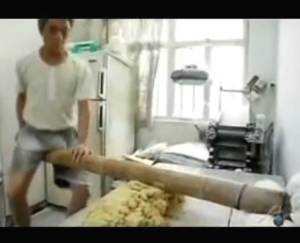 Food Court: Josh takes Anthony to check out a food court that's unlike its counterparts in most other parts of the world; the food is of incredible caliber. They eat at a food stall that serves bamboo noodles that are still handmade for a superior taste and texture. The bamboo noodles are served with shrimp eggs sprinkled on top, some rendered pork fat (lard), and a broth.
Food Court: Josh takes Anthony to check out a food court that's unlike its counterparts in most other parts of the world; the food is of incredible caliber. They eat at a food stall that serves bamboo noodles that are still handmade for a superior taste and texture. The bamboo noodles are served with shrimp eggs sprinkled on top, some rendered pork fat (lard), and a broth.
Handmade Bamboo Factory: Josh takes Anthony to see one of the few remaining cooks who still makes handmade bamboo noodles (also known as jook-sing noodles). Anthony watches in reverence as this master painstakingly practices what is sadly becoming a dying centuries-old art. The noodles are made with egg, the highest quality of which is made with duck egg, and is considered one of the more rare noodle in existence. Historically the chef rides a bamboo log to press the eggs, flour, and other ingredients together.
Happy Valley Racecourse: Anthony takes in a night of betting and racing at Happy Valley Racecourse, located in Happy Valley on Hong Kong island. Anthony witnesses the fervor of the "Hongkongese" for horse racing and gambling, and discovers firsthand how infectious the sport is. Unfortunately, he can't seem to pick a winner.
Happy Valley Racecourse was first built in 1845 to provide horse racing for the British people in Hong Kong. Over the years, horse racing became more and more popular among the Chinese residents. Per capita, more money is bet on horses here than anywhere else in the world. Jockeys are as big as NBA stars in the U.S.
Tung Po Seafood Restaurant: Anthony joins fellow chef Frank for some post racetrack seafood at Tung Po Seafood Restaurant, located in North Point in the Eastern District of Hong Kong. The restaurant is a modern version of a dai pai dong, a type of open-air food stall once very popular in Hong Kong, but scarce today. Today, most successful dai pai dongs survive by operating in air-conditioned food courts. Anthony meets Bobby, the head chef and owner. They dine on various types of delicious seafood consisting of deep-fried mantis shrimp, fish fins, black-ink squid balls with noodles, stir-fried prawns, pig knuckles, soup made with tripe, intestines and clams.
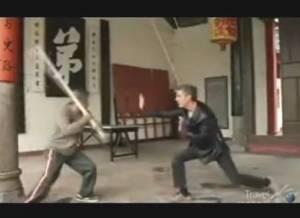 Hong Kong Kung fu Movie Studio: Being a consummate fan of the cinema, including Asian cinema, Anthony gets to star in his own short chopsocky flick reminiscent of the maritial arts movies made primarily in Hong Kong and Taiwan during the 1960s and 1970s. Afterwards, he and the rest of the cast and crew break for lunch. They dine on poon choi, also known as pun choi or "Big Bowl Feast", a traditional type of dish originating from Hong Kong village cuisine.
Hong Kong Kung fu Movie Studio: Being a consummate fan of the cinema, including Asian cinema, Anthony gets to star in his own short chopsocky flick reminiscent of the maritial arts movies made primarily in Hong Kong and Taiwan during the 1960s and 1970s. Afterwards, he and the rest of the cast and crew break for lunch. They dine on poon choi, also known as pun choi or "Big Bowl Feast", a traditional type of dish originating from Hong Kong village cuisine.
Poon Choi includes ingredients such as pork, beef, lamb, chicken, duck, abalone, ginseng, shark fin, fish maw, prawn, crab, dried mushroom, fishballs, squid, dried eel, dried shrimp, pigskin, beancurd and Chinese radish. Poon Choi is special in that it is composed of many layers of different ingredients. It is also eaten layer by layer instead of "stirring everything up", but impatient diners may snatch up the popular daikon radish at the bottom first using shared chopsticks.
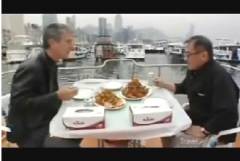 Cooking Ship Cruise: Anthony and Frank dine on a cooking ship in Causeway Bay Typhoon Shelter located in Causeway Bay. A typhoon shelter, as its name suggests, is used by small-to-medium ships as a shelter against gale force winds and rough seas during a typhoon strike. It is also used to moor yachts. The chef prepares the famous typhoon shelter crab, believed to have originated from the typhoon shelters. It is commonly prepared with crab meat, fried garlic, scallion, red chili and black beans.
Cooking Ship Cruise: Anthony and Frank dine on a cooking ship in Causeway Bay Typhoon Shelter located in Causeway Bay. A typhoon shelter, as its name suggests, is used by small-to-medium ships as a shelter against gale force winds and rough seas during a typhoon strike. It is also used to moor yachts. The chef prepares the famous typhoon shelter crab, believed to have originated from the typhoon shelters. It is commonly prepared with crab meat, fried garlic, scallion, red chili and black beans.
Bo Innovation: Anthony visits chef Alvin Leung at his restaurant Bo Innovation located in the Central District. This self-schooled cook with the tattooed moniker "demon chef" is causing some controversy and is famous for his innovative fusion-style cooking. Chef Leung is also known for deconstructing traditional dishes and making them new and innovative, such as the one Anthony enjoyed: ice cream made of preserved Chinese meat and liver sausage topped with rice crispy; toro (the fatty cut of the fish) sushi; crispy dry tomatoes with air-dried foie gras; lobster with Szechuan sauce which is made with Szechuan peppercorn, bouillon base, and har gao pasta; and Wagyu beef, refined, in broth made with dry shrimps, scallop, and the beef.
Lin Heung Teahouse: Anthony joins some friends at Lin Heung Teahouse to experience traditional Hong Kong dim sum. This popular teahouse is packed with impatient diners shoving, jabbing, and elbowing one another to get their food and any available seating. Anthony samples such delicacies as chicken feet simmered with soy sauce, pork liver dumplings, beef tripe, pork ribs, radish cake with ham, beef dumplings, har gao, and Chinese-style steamed sponge cake
Dim sum is a Cantonese term for a type of Chinese dish that involves small individual portions of food, usually served in a small steamer basket or on a small plate. Traditional dim sum includes various types of steamed buns such as cha siu baau, dumplings and rice noodle rolls, which contain a range of ingredients, including beef, chicken, pork, prawns and ingredients, including beef, chicken, pork, and vegetarian options. Many dim sum restaurants also offer plates of steamed green vegetables, roasted meats, congee porridge and other soups. The drinking of tea is as important to dim sum as the food. A popular tea which is said to aid in digestion is bolay, which is a strong, fermented tea. Chrysanthemum, oolong and green tea can be served as well. It is customary to pour tea for others during dim sum before filling one's own cup.
Anthony can't help observing that the scenario is a perfect metaphor for his Hong Kong experience and that the hectic pace in the teahouse represents Hong Kong as a whole—fast-paced, small spaces, you've got to be a little aggressive to get what you want, and food-crazy. Yes, most definitely, delectably food-crazy.
Episodes:
 |
ARGENTINA: From the Tango to paragliding to cattle rustling to trekking along icy glaciers, Anthony experiences it all. |
 |
AUSTRALIA: Melbourne has been described as San Francisco without the fog. Anthony is off to discover what makes it so special. |
 |
BERLIN: Anthony finds himself in Berlin, a city that is for him both good and evil, Eastern and Western, repulsive and appealing. |
 |
BRAZIL: Some say São Paulo feels like LA threw up on NYC. But Anthony's back for the great food and its welcoming people. |
 |
CALCUTTA & BOMBAY: Anthony revisits his love for India's vibrant culture, cuisine & communities with a trip to Kolkata & Mumbai. |
 |
COLOMBIA: A bright and beautiful country that has gone from drug capital to food capital. Anthony explores its unique cuisine. |
 |
EGYPT: Anthony skips the long lines and tour buses, and visits with Egyptian locals to get a taste for what it means to be Egyptian. |
 |
GHANA: Anthony heads to Ghana, West Africa, a land of old forts and slave castles, and a culture filled with great food and music. |
 |
GREEK ISLES: Anthony is on a culinary odyssey to discover if Greece really does have the world's healthiest diet. |
 |
IRELAND: Ireland's steeped in history and traditions, both oral & written. Anthony dispels the myths that it has the worst food on the planet. |
 |
JAMAICA: Jamaica is a vibrant, colorful land full of resorts and reggae music. Anthony is there to uncover the lesser-known Jamaica. |
 |
KOREA: Anthony gives in to his employee's pressure to visit Korea and, next thing you know, they're in Seoul and the adventure begins. |
 |
MEXICO: Carlos, a head chef in NYC and good friend, gives Anthony a culinary tour of his hometown Puebla and nearby Mexico City. |
 |
OSAKA (Japan): Anthony learns all about kuidaore, which means to bankrupt oneself with extravagance in food and drink! |
 |
PARIS: In this very first episode of the series, Anthony heads to the "City of Light" to show, at least the Americans, why the French don't suck. |
 |
PERU: Anthony is on a mission to obtain personal enlightenment in a land of ancient culture, rich cuisine, and vibrant people. |
 |
QUEBEC (Canada): Anthony is off to Québec to indulge in one of his most hedonistic pleasures–foie gras (fatty duck liver). |
 |
RAJASTHAN (India): From gorgeous sights to enticing smells, Anthony explores the magical and delicious offerings of Rajasthan. |
 |
ROME: Anthony adopts the mindset of the Roman people–living a simple life and eating fresh, seasonal ingredients. |
 |
RUSSIA: Anthony explores Russia, where the food is hearty. Along the way he meets a former Cold War spy and Miss Russia. |
 |
SHANGHAI (China): Anthony is back in China. From Shanghai to Tibet, he searches for the mythical Shangri-La. |
 |
SICILY: Anthony starts his gastronomic tour through Sicily in style by sharing a spleen sandwich with Sicily's president. |
 |
SINGAPORE: Singapore is serious about food and offers up a cuisine like no other. Anthony dives in head-first. |
 |
SPAIN: According to Anthony, outside of Asia, Spain is the single greatest place for culinary achievement in the world. |
 |
TOKYO: Anthony is off to Tokyo in search of the relationship between a perfect piece of sushi and a perfect knife blade. |
 |
TUSCANY: Anthony travels to the beautiful Tuscan countryside to visit with friends and enjoy some homemade pasta that's out of this world. |
 |
URUGUAY: Anthony and his brother are on a mission to connect with their roots in Uruguay after learning that Bourdains once settled here. |
 |
VANCOUVER (Canada): Anthony visits Vancouver, home to a thriving film industry, gorgeous scenery, and an evolving food scene. |
Contact Us | Shop | Sitemap | Join Our Team | Investors | Advertise | Web Design Services
Community | Foodies' Choice | Meetup Groups | Chat | Blogs | Forums | Submit Your Site | Resources

